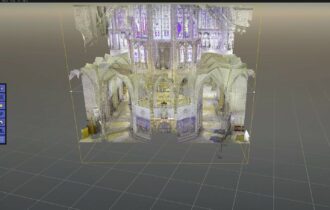
Immersive technologies: Retail's next step?
The pandemic has caused consumers’ shopping habits to change radically towards e-commerce models. But the demand for shopping is also shifting to technologies that enhance the user experience.
Retailers are seeing how digital products are gaining more strength. They are incorporating immersive technologies in their stores, such as 3D modeling and augmented or virtual reality, to interact with consumers differently.
These trends are an excellent opportunity for retailers, who are seeing a significant boost in their business thanks to advances in WebXR, WebAR, or 5G services. Technology is completely changing the global retail landscape, which is reflected in the numbers. 68% of consumers in Asia-Pacific demand more immersive technology experiences, compared to 58% in Europe. Meanwhile, studies show that, in the United States, 66 million users (20% of the population) will use virtual reality, and 110 million (33% of the population) will use augmented reality at least once a month by 2023.
Consumers have spoken and are demanding more immersive experiences in their daily lives. The retail industry must reinvent itself to meet its demands, and here are some tips and use cases for doing just that.
Immersive technologies definition
Immersive technologies try to emulate a physical world through a digital or simulated one, creating the sensation of immersion in another world.
They modify sensory perception and offer experiences that break the barriers of space and time and are unique and personalized. To achieve this, technologies such as augmented, virtual and mixed reality are combined.
Benefits of Immersive Technology
The power of immersive technologies lies in their ability to immerse users in a safe and unique environment that would not be possible in a physical location. Their benefits are numerous, and the main ones are:
- Creating a more robust connection: immersive technologies can recreate real sensations for different situations, in which the user will find himself in a familiar environment, but in a much simpler way.
- Fewer distractions: this type of experience moves away from the usual “multitasking,” as it creates an entirely virtual environment from which it is difficult to disconnect to answer other types of notifications or be distracted by other stimuli.
- Relevant information is better communicated: this type of technology helps to visualize the most critical information at a glance, in addition to receiving instructions to perform specific tasks…
- Time-saving: having both hands free helps to streamline processes, reduce risks and save time.
How retailers are adapting to the customer and technology trends
Current trends are encouraging retailers to reinvent the shopping experience, both in-store and in digital commerce. Technology allows them to connect with customers much closer and more innovatively. Here are some examples of immersive retail:
More attractive experiences
Thanks to the rise of virtual and augmented reality-based digital interactions, consumer preferences have been created with their favorite brands through immersive retail experiences.
Incorporating immersive retail technologies in stores and enabling touchless interactions is the perfect way to enhance the overall shopping experience for customers.
Store redesign
One type of commerce that is gaining more and more traction is the virtual store, which combines the best of both worlds, allowing you to visualize various designs before implementing them.
Intelligent virtual store design (IVSD) technology can even generate an optimal store layout to help the customer see the highest-value products simultaneously.
Employee training
Virtual reality also allows companies to train employees for high-stress events like Black Friday. The technology helps prepare them to monitor product sections, clean up or pick up dropped items, or identify potential thieves.
The initial investment may be a barrier at first, but the technology is highly scalable, and training programs can be centralized and shared across multiple locations.
Optimization of inventory space
Mixed reality is the perfect solution to offer customers the full selection of products available, but without filling the entire retail space and cluttering it or requiring a larger one.
Potential customers can put on the mixed reality glasses and interact with the product they are interested in, as well as “virtually transporting” it to the specific location it is intended for. Or for example, if it is a cosmetics store, customers can try on makeup in a mixed reality mirror and make a quicker decision.
Virtual testing
3D products provide companies with a much more sustainable model by replacing traditional manual processes with digital processes.
They also speed up merchandising processes, eliminate traditional logistical challenges and enable consumers to make more confident decisions. This translates into more purchases and fewer returns and applies to any retail sector.
The virtual goods market has reached $190 billion. And this growth is accelerating even faster thanks to the emergence of NFTs, metaverses, and avatars. As a result, retailers will find a great ally in immersive retail technologies, offering their customers unique, memorable, and interactive experiences that make a difference.
With Evergine, we guide our clients to identify the solutions that best suit their business needs. Do you want to know where your business is headed? We can help you!


